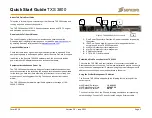
1080 North Crooks Road, Clawson, MI 48017 • Phone: 248-435-0700
5. Turn the power supply off.
6. Check the continuity of the individual wires of
the cable between the power supply and the
LDT. Check for continuity from one end of the
cable to the other. Also, verify that no shorts
exist between pins.
7. Reconnect the mating connector to the LDT.
8. Turn power supply on.
9. Using a digital voltmeter, check the power
supply’s + and - terminals for a voltage between
+15 and +26 VDC.
Low voltage readings may indicate a power supply
with a wattage (current) rating that is too low. (Each
LDT requires 3 watts). If the cabling checks out in
step 6 and the voltage is below +15 VDC, check the
power supply current rating. If voltage is between
+15 to +26 VDC and the LDT is still inoperative,
contact factory.
Bipolar Power Supply Check
This section will help determine if the power supply
is adequate for the LDT to operate properly, or if the
LDT’s cable has a short or open.
In order for the BlueOx to operate properly, the
external power supply must p15 and -15
VDC ± 10%. A power supply providing voltage
above this specified range may cause damage to
the LDT. A power supply providing power below
this specified range will not be sufficient to power
the LDT. When powering more than one BlueOx
on a single power supply, each BlueOx requires a
maximum of 100mA from each supply rail.
If the LDT is not operating properly, the LDT’s cable
may have an open or short, or the power supply is
not supplying sufficient power. To verify this, perform
the following steps:
1. Turn the power supply off.
2. Remove the mating connector from the LDT.
3. Turn the power supply on.
4. Using a digital voltmeter, check pins B (GND)
and C (+) from the mating end of the cable for
+15 VDC. Also, check from pins B (GND) to J (-)
for -15 VDC.
NOTE
: LDTs with potted cable assemblies should
be checked for proper voltage at the power supply
terminals. This cable cannot be removed from the
LDT.
If the +15 is b13.5 and +16.5 and the -15 is
between -13.5 and -16.5, turn the power supply off
and go to step 7. If the reading is below ±13.5 VDC,
either the power supply is not providing enough
power or the LDT’s cable has a short. Readings of
no voltage or minimal voltage (less than 5 volts)
may be due to a short in the cabling. If reading is
not +15 and -15 VDC, go to step 5.
5. Turn the power supply off.
6. Check the continuity of the individual wires of
the cable between the power supply and the
LDT. Check for continuity from one end of the
cable to the other. Also, verify that no shorts
exist between pins.
7. Reconnect the mating connector to the LDT.
8. Turn the power supply on.
9. Using a digital voltmeter, check the power
supply’s +15 and -15 terminals for the proper
voltage levels, ±15 VDC ±10%.
Low voltage readings may indicate a power supply
with a wattage (current) rating that is too low. (Each
LDT requires 100mA from both the + and - supply
rails.). If the cabling checks out in step 6 and the
voltage is below ±15 VDC ±10%, check the power
supply current rating. If voltage is at ±15 VDC ±10%
and the LDT is still inoperative, contact factory.
28









































